by Calculated Risk on 5/07/2023 09:32:00 AM
Sunday, May 07, 2023
Realtor.com Reports Weekly Active Inventory Up 35% YoY; New Listings Down 22% YoY
Realtor.com has monthly and weekly data on the existing home market. Here is their weekly report from chief economist Danielle Hale: Weekly Housing Trends View — Data Week Ending Apr 29, 2023
• Active inventory was up at a slower pace, with for-sale homes up just 35% above one year ago. The number of homes for sale continues to grow, but compared to one year ago, the pace is slowing.
...
• New listings–a measure of sellers putting homes up for sale–were down again this week, by 22% from one year ago. The number of newly listed homes has been lower than the same time the previous year for the past 43 weeks.
 Here is a graph of the year-over-year change in inventory according to realtor.com.
Here is a graph of the year-over-year change in inventory according to realtor.com. Inventory is still up year-over-year - from record lows - however, the YoY increase has slowed sharply recently.
Saturday, May 06, 2023
Real Estate Newsletter Articles this Week: Year-over-year Rent Growth Continues to Decelerate
by Calculated Risk on 5/06/2023 02:11:00 PM
At the Calculated Risk Real Estate Newsletter this week:
• Year-over-year Rent Growth Continues to Decelerate
• Lawler: Invitation Homes Net Seller of Single-Family Properties for Second Straight Quarter
• A Policy Proposal to Increase the Utilization of the Current Housing Stock
• Black Knight Mortgage Monitor: Home Prices Increased in March; Prices Up 1.0% YoY
• Early Look at Local Housing Markets in April
This is usually published 4 to 6 times a week and provides more in-depth analysis of the housing market.
You can subscribe at https://calculatedrisk.substack.com/
Most content is available for free (and no Ads), but please subscribe!
Schedule for Week of May 7, 2023
by Calculated Risk on 5/06/2023 08:11:00 AM
The key report this week is April CPI.
Note: The Fed will release the Senior Loan Officer Opinion Survey on Bank Lending Practices (SLOOS) on Monday. This will provide some information on recent credit tightening.
2:00 PM: Senior Loan Officer Opinion Survey on Bank Lending Practices for April.
6:00 AM ET: NFIB Small Business Optimism Index for April.
7:00 AM ET: The Mortgage Bankers Association (MBA) will release the results for the mortgage purchase applications index.
8:30 AM: The Consumer Price Index for April from the BLS. The consensus is for 0.4% increase in CPI (up 5.0% YoY), and a 0.3% increase in core CPI (up 5.5% YoY).
8:30 AM: The initial weekly unemployment claims report will be released. The consensus is for 250 thousand initial claims, up from 242 thousand last week.
8:30 AM: The Producer Price Index for April from the BLS. The consensus is for a 0.3% increase in PPI, and a 0.3% increase in core PPI.
10:00 AM: University of Michigan's Consumer sentiment index (Preliminary for May).
Friday, May 05, 2023
COVID May 5, 2023, Update: New Pandemic Low for Hospitalizations
by Calculated Risk on 5/05/2023 09:04:00 PM
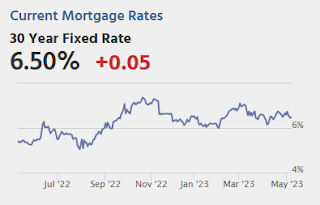
| COVID Metrics | ||||
|---|---|---|---|---|
| Now | Week Ago | Goal | ||
| New Cases per Week2 | 77,924 | 90,318 | ≤35,0001 | |
| Hospitalized2 | 8,861 | 10,214 | ≤3,0001 | |
| Deaths per Week2🚩 | 1,109 | 1,049 | ≤3501 | |
| 1my goals to stop weekly posts, 2Weekly for Cases, Currently Hospitalized, and Deaths 🚩 Increasing number weekly for Cases, Hospitalized, and Deaths ✅ Goal met. | ||||
 Click on graph for larger image.
Click on graph for larger image.This graph shows the weekly (columns) number of deaths reported.
AAR: April Rail Carloads Increased, Intermodal Decreased Year-over-year
by Calculated Risk on 5/05/2023 03:01:00 PM
From the Association of American Railroads (AAR) Rail Time Indicators. Graphs and excerpts reprinted with permission.
Rail intermodal continues to struggle. U.S. intermodal volume was 12.7% lower in April 2023 than in April 2022. April’s decline was the 14th straight and 20th in the past 21 months. In 2023 through April, volume was 3.97 million containers and trailers, down 10.9% (484,228) from last year and the fewest for January to April since 2012. Year-to-date container volume was down 9.5%; trailer volume was down 28.3%. Trailers accounted for 5.8% of intermodal units In the first four months of 2023, a record low.
Meanwhile, carloads were better: total originated carloads on U.S. railroads in April were up 1.8% over April 2022 and averaged 234,159 per week — the most in six months. Year-to-date total carloads were 3.93 million, up 0.6% over the first four months of 2022 and the most for January to April since 2019.
emphasis added
 Click on graph for larger image.
Click on graph for larger image.This graph from the Rail Time Indicators report shows the six-week average of U.S. Carloads in 2021, 2022 and 2022:
Originated carloads on U.S. railroads in April 2023 totaled 936,637, up 1.8% over April 2022. Total carloads averaged 234,159 per week in April 2023, the most in six months.
For the first four months of 2023, total carloads were 3.93 million, up 0.6% (23,161 carloads) over the first four months of 2022 and the most for January to April since 2019.
 The second graph shows the six-week average (not monthly) of U.S. intermodal in 2021, 2022 and 2023: (using intermodal or shipping containers):
The second graph shows the six-week average (not monthly) of U.S. intermodal in 2021, 2022 and 2023: (using intermodal or shipping containers):U.S. railroads originated 945,313 intermodal containers and trailers in April 2023, down 12.7% (137,879 units) from April 2022. April’s decline was the 14th straight for intermodal. Originations averaged 236,328 units per week in April 2023, the most in five months.
In 2023 through April, intermodal volume was 3.97 million units, down 10.9% (484,228) from last year and the fewest for January to April since 2012.
Wholesale Used Car Prices Decreased in April; Down 4.4% Year-over-year
by Calculated Risk on 5/05/2023 01:46:00 PM
From Manheim Consulting today: Wholesale Used-Vehicle Prices See Sizable Decline in April
Wholesale used-vehicle prices (on a mix, mileage, and seasonally adjusted basis) decreased 3.0% in April from March. The Manheim Used Vehicle Value Index (MUVVI) dropped to 230.8, down 4.4% from a year ago.
“While values increased 8.6% through the first quarter from December, the market has reversed course in April, with our monthly figures showing a month-over-month decline for the first time in 2023,” said Chris Frey, senior manager of Economic and Industry Insights for Cox Automotive. “Values in April also continue to be lower year over year. We’ve experienced eight straight months of year-over-year declines, averaging 8.3%, and it’s likely not over yet. During the financial crisis, we had 16 months of annualized declines, averaging 5.8%. Though I’m not predicting doom, we’ve surely started a second, and more rapid, decent off the pandemic peak of January 2022.”
emphasis added
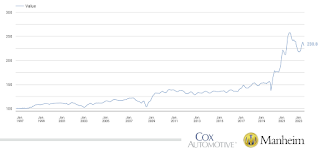 Click on graph for larger image.
Click on graph for larger image.This index from Manheim Consulting is based on all completed sales transactions at Manheim’s U.S. auctions.
Early Look at Local Housing Markets in April
by Calculated Risk on 5/05/2023 10:36:00 AM
Today, in the Calculated Risk Real Estate Newsletter: Early Look at Local Housing Markets in April
A brief excerpt:
This is a look at a few early reporting local markets in April. I’m tracking about 40 local housing markets in the US. Some of the 40 markets are states, and some are metropolitan areas. I’ll update these tables throughout the month as additional data is released.There is much more in the article. You can subscribe at https://calculatedrisk.substack.com/
Closed sales in April were mostly for contracts signed in February and March. Since 30-year fixed mortgage rates were over 6% for all of February and March - compared to the 4% range the previous year - closed sales were down significantly year-over-year in April.
It is likely sales were down more year-over-year in April than in March, however, the impact was probably not as severe as for closed sales in December and January (rates were the highest in October and November 2022 when contracts were signed for closing in December and January).
...
In April, sales in these markets were down 34.5%. In March, these same markets were down 26.5% YoY Not Seasonally Adjusted (NSA).
This is a larger YoY decline NSA than in March for these early reporting markets, however there was one less selling day in April this year. This early data suggests the April existing home sales report will show another significant YoY decline, and the 20th consecutive month with a YoY decline in sales.
This was a just a few early reporting markets. Many more local markets to come!
Comments on April Employment Report
by Calculated Risk on 5/05/2023 09:23:00 AM
The headline jobs number in the April employment report was above expectations, however employment for the previous two months was revised down by 149,000, combined. The participation rate and employment population ratio were unchanged, and the unemployment rate decreased to 3.4%.
In April, the year-over-year employment change was 4.00 million jobs.
Prime (25 to 54 Years Old) Participation
 Since the overall participation rate is impacted by both cyclical (recession) and demographic (aging population, younger people staying in school) reasons, here is the employment-population ratio for the key working age group: 25 to 54 years old.
Since the overall participation rate is impacted by both cyclical (recession) and demographic (aging population, younger people staying in school) reasons, here is the employment-population ratio for the key working age group: 25 to 54 years old.The 25 to 54 participation rate was increased in April to 83.3% from 83.1% in March, and the 25 to 54 employment population ratio increased to 80.8% from 80.7% the previous month.
Average Hourly Wages
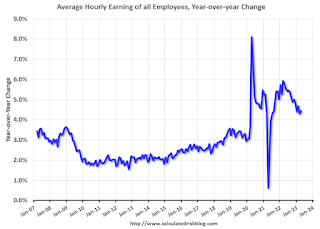 The graph shows the nominal year-over-year change in "Average Hourly Earnings" for all private employees from the Current Employment Statistics (CES).
The graph shows the nominal year-over-year change in "Average Hourly Earnings" for all private employees from the Current Employment Statistics (CES). Wage growth has trended down after peaking at 5.9% YoY in March 2022 and was at 4.4% YoY in April.
Part Time for Economic Reasons
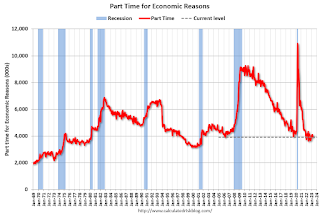 From the BLS report:
From the BLS report:"The number of persons employed part time for economic reasons, at 3.9 million, was little changed in April. These individuals, who would have preferred full-time employment, were working part time because their hours had been reduced or they were unable to find full-time jobs."The number of persons working part time for economic reasons decreased in April to 3.903 million from 4.102 million in March. This is below pre-recession levels.
These workers are included in the alternate measure of labor underutilization (U-6) that decreased to 6.6% from 6.7% in the previous month. This is down from the record high in April 22.9% and up slightly from the lowest level on record (seasonally adjusted) in December 2022 (6.5%). (This series started in 1994). This measure is below the level in February 2020 (pre-pandemic).
Unemployed over 26 Weeks
 This graph shows the number of workers unemployed for 27 weeks or more.
This graph shows the number of workers unemployed for 27 weeks or more. According to the BLS, there are 1.156 million workers who have been unemployed for more than 26 weeks and still want a job, up from 1.104 million the previous month.
This is at pre-pandemic levels.
Summary:
The headline monthly jobs number was above expectations; however, employment for the previous two months was revised down by 149,000, combined. The headline unemployment rate decreased to 3.4% - the lowest in over 50 years!
April Employment Report: 253 thousand Jobs, 3.4% Unemployment Rate
by Calculated Risk on 5/05/2023 08:44:00 AM
From the BLS:
Total nonfarm payroll employment rose by 253,000 in April, and the unemployment rate changed little at 3.4 percent, the U.S. Bureau of Labor Statistics reported today. Employment continued to trend up in professional and business services, health care, leisure and hospitality, and social assistance.
...
The change in total nonfarm payroll employment for February was revised down by 78,000, from +326,000 to +248,000, and the change for March was revised down by 71,000, from +236,000 to +165,000. With these revisions, employment in February and March combined is 149,000 lower than previously reported.
emphasis added
 Click on graph for larger image.
Click on graph for larger image.The first graph shows the jobs added per month since January 2021.
Payrolls for February and January were revised down 149 thousand, combined.
 The second graph shows the year-over-year change in total non-farm employment since 1968.
The second graph shows the year-over-year change in total non-farm employment since 1968.In April, the year-over-year change was 4.00 million jobs. Employment was up significantly year-over-year.
The third graph shows the employment population ratio and the participation rate.
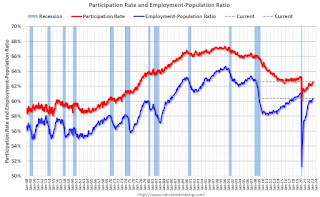 The Labor Force Participation Rate was unchanged at 62.6% in April, from 62.6% in March. This is the percentage of the working age population in the labor force.
The Labor Force Participation Rate was unchanged at 62.6% in April, from 62.6% in March. This is the percentage of the working age population in the labor force. The Employment-Population ratio was unchanged at 60.4% from 60.4% (blue line).
I'll post the 25 to 54 age group employment-population ratio graph later.
 The fourth graph shows the unemployment rate.
The fourth graph shows the unemployment rate. The unemployment rate decreased in April to 3.4% from 3.5% in March.
This was above consensus expectations; however, February and March payrolls were revised down by 149,000 combined.
Thursday, May 04, 2023
Friday: April Employment Report
by Calculated Risk on 5/04/2023 09:11:00 PM
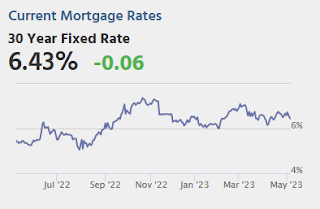
Friday:
• At 8:30 AM: Employment Report for April. The consensus is for 178,000 jobs added, and for the unemployment rate to increase to 3.6%.


